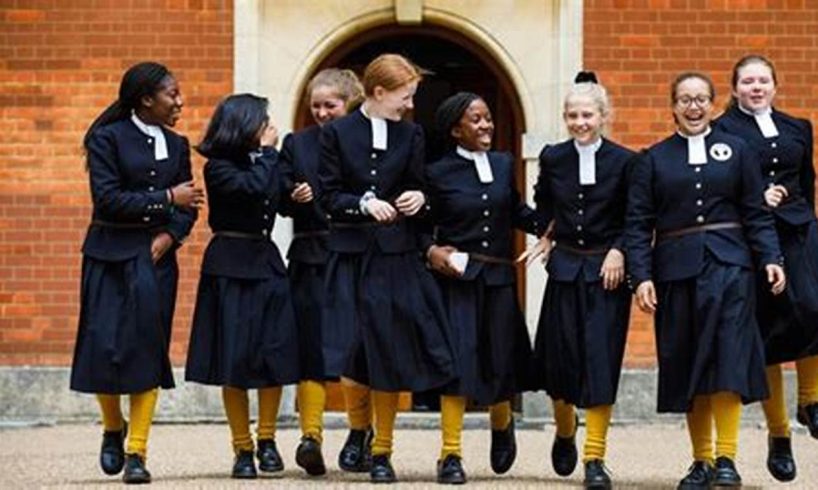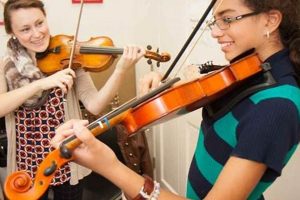
Private school uniforms are distinctive sets of clothing worn by students of private educational institutions. These uniforms typically comprise a shirt, trousers or skirt, and a blazer or sweater bearing the school’s logo or crest.
Uniforms in private schools serve several purposes. Firstly, they foster a sense of unity and belonging among students, promoting school spirit and identity. Secondly, they eliminate socioeconomic disparities by ensuring that all students dress similarly, regardless of their backgrounds. Uniforms also help maintain discipline and order, as they set clear expectations regarding appropriate attire. Moreover, they can enhance safety by making it easier to identify students and deter unauthorized individuals from entering the school premises.
The implementation of private school uniforms has a long history, dating back to the 16th century in England. Today, uniforms are a common sight in private schools worldwide, with each institution adopting its unique design and color scheme. While some schools enforce strict adherence to uniform regulations, others allow for some degree of flexibility and personalization.
1. Identity
In private schools, uniforms play a crucial role in shaping students’ identity and fostering a sense of belonging. By wearing a standardized dress code, students become part of a cohesive unit, reinforcing their connection to the school community. Uniforms eliminate distinctions based on personal style or socioeconomic background, creating a more inclusive and equitable environment where students can focus on their academic pursuits without feeling self-conscious about their appearance.
The sense of belonging fostered by uniforms extends beyond the physical appearance. By representing their school, students develop a sense of pride and loyalty towards their institution. Uniforms become a symbol of shared values, traditions, and aspirations, further strengthening the bond between students and their school. This sense of identity and belonging can have a positive impact on students’ overall well-being, motivation, and academic performance.
Numerous studies have demonstrated the positive effects of school uniforms on student identity and school spirit. For example, a study conducted by the University of Arkansas found that students who attended schools with mandatory uniforms reported higher levels of school pride and a stronger sense of belonging compared to students in schools without uniforms. Another study by the University of California, Los Angeles, showed that students in schools with uniforms had improved self-esteem and reduced anxiety about their appearance.
In conclusion, the connection between “Identity: Uniforms foster a sense of belonging and school spirit.” and “private schools uniforms” is vital. Uniforms contribute to a more inclusive, equitable, and supportive school environment, where students can develop a strong sense of identity and belonging. This, in turn, can positively impact their overall well-being, motivation, and academic success.
2. Equality
In an era marked by increasing economic inequality, private school uniforms serve as a powerful equalizer, eliminating socioeconomic disparities in appearance among students. By requiring all students to wear the same basic clothing, uniforms break down the visible barriers that often separate children from different backgrounds. This creates a more level playing field, allowing students to focus on their studies without the added burden of worrying about their appearance or feeling self-conscious about their family’s financial status.
The importance of eliminating socioeconomic disparities in appearance cannot be overstated. Research has shown that students from disadvantaged backgrounds often face discrimination and prejudice based on their clothing. They may be perceived as less intelligent, less capable, or less deserving of respect than their more affluent peers. This can have a devastating impact on their self-esteem and academic performance. Uniforms help to break down these barriers by creating a more equitable and inclusive environment where all students feel valued and respected.
In practice, the benefits of school uniforms in promoting equality are widely recognized. A study conducted by the University of Arkansas found that schools with mandatory uniforms had lower rates of bullying and discrimination based on socioeconomic status. Another study by the University of California, Los Angeles, showed that students in schools with uniforms had improved attendance and higher graduation rates, particularly among students from low-income families.
In conclusion, the connection between “Equality: They eliminate socioeconomic disparities in appearance.” and “private schools uniforms” is crucial. Uniforms play a vital role in creating a more just and equitable educational environment, where all students have the opportunity to succeed regardless of their socioeconomic background. By breaking down the visible barriers that often separate children from different backgrounds, uniforms help to level the playing field and ensure that all students feel valued and respected.
3. Discipline
In the context of private schools, uniforms play a significant role in promoting discipline and order by establishing clear expectations for student attire. By adhering to a standardized dress code, students learn the importance of following rules and regulations, which can translate into improved behavior and academic performance. Uniforms help to create a more focused and orderly learning environment, free from distractions caused by inappropriate or revealing clothing.
The connection between discipline and private school uniforms is supported by research. A study conducted by the University of California, Los Angeles, found that schools with mandatory uniforms had lower rates of disruptive behavior and higher levels of student engagement. Another study by the University of Arkansas showed that students in schools with uniforms had improved attendance and reduced tardiness.
Beyond the practical benefits, uniforms also teach students valuable life lessons about self-discipline and respect for authority. By conforming to a prescribed dress code, students learn to prioritize the needs of the collective over individual preferences. This can help them develop a sense of responsibility and accountability, which are essential qualities for success in school and beyond.
In conclusion, the connection between “Discipline: Uniforms promote order and adherence to dress codes.” and “private schools uniforms” is undeniable. Uniforms play a crucial role in creating a disciplined and orderly learning environment, teaching students valuable life lessons about following rules, self-discipline, and respect for authority. This, in turn, can positively impact student behavior, engagement, and academic performance.
4. Safety
In the context of private schools, uniforms play a crucial role in enhancing safety by aiding in student identification and deterring unauthorized individuals. Uniforms help to create a clear and recognizable distinction between students and non-students, making it easier for school staff and security personnel to identify and monitor individuals on campus.
- Student Identification: Uniforms make it easier for teachers, staff, and security personnel to quickly and accurately identify students. This is especially important in large schools or during events with a high volume of people, as it helps prevent unauthorized individuals from gaining access to the school or interacting with students.
- Deterrence of Unauthorized Individuals: Uniforms act as a deterrent to unauthorized individuals, such as trespassers or potential intruders. When everyone on campus is wearing a uniform, it is easier to spot individuals who do not belong. This can help prevent unauthorized individuals from entering the school and potentially causing harm to students or staff.
- Emergency Situations: In the event of an emergency, uniforms can aid in student identification and evacuation. Uniformed students are easier to locate and account for, which can save valuable time during an evacuation or lockdown situation.
- Improved Campus Security: Uniforms contribute to an overall improvement in campus security by creating a more controlled and recognizable environment. When everyone is wearing a uniform, it is easier to identify and respond to potential threats or suspicious behavior.
In conclusion, the connection between “Safety: They aid in student identification and deter unauthorized individuals.” and “private schools uniforms” is undeniable. Uniforms play a vital role in creating a safer and more secure learning environment by aiding in student identification, deterring unauthorized individuals, facilitating emergency situations, and improving overall campus security.
5. History
The tradition of school uniforms has a long and rich history, dating back to the 16th century in England. The first recorded use of school uniforms was at Christ’s Hospital, a boarding school in London, in 1552. The uniforms were designed to create a sense of equality among the students and to distinguish them from the poor children who attended charity schools. Over time, the wearing of school uniforms became more widespread, and by the 19th century, most private schools in England required their students to wear uniforms.
The tradition of school uniforms was brought to the United States in the late 19th century by private schools such as Phillips Academy and Groton School. These schools adopted uniforms as a way to instill discipline and create a sense of community among their students. In the early 20th century, the wearing of school uniforms became more common in public schools, and by the 1950s, most public schools in the United States required their students to wear uniforms.
Today, school uniforms are a common sight in both private and public schools throughout the world. They continue to serve the same purposes as they did centuries ago: to create a sense of equality, to instill discipline, and to create a sense of community. In addition, school uniforms have been shown to have a number of other benefits, such as improving student safety and academic performance.
6. Customization
Private schools often allow for some degree of customization within their uniform guidelines, giving students the opportunity to express their individuality while still adhering to the school’s dress code. This approach provides a balance between the uniformity and the desire for personal expression.
- Choice of accessories: Many schools allow students to accessorize their uniforms with items such as belts, ties, scarves, and jewelry. This allows students to add a personal touch to their appearance without compromising the overall uniformity of the dress code.
- Variations in color and style: Some schools offer a range of uniform options in different colors or styles, giving students the opportunity to choose the ones that best suit their preferences. This can include variations in the shade of a particular color, the length of skirts or pants, or the design of shirts and blouses.
- School spirit items: Many schools allow students to wear school spirit items, such as sweatshirts, t-shirts, or hats, as part of their uniforms. This allows students to show their support for their school while still adhering to the dress code.
- Cultural and religious considerations: Some schools make accommodations for students who need to wear certain clothing items for cultural or religious reasons. This may include allowing students to wear headscarves, yarmulkes, or other items that are part of their cultural or religious identity.
In conclusion, allowing for some degree of customization within uniform guidelines in private schools provides students with a way to express their individuality while still maintaining the uniformity and consistency of the school’s dress code. This approach can help students feel more comfortable and confident in their uniforms, which can have a positive impact on their overall school experience.
7. Regulation
The enforcement of school uniform policies varies greatly among private schools, ranging from strict adherence to more flexible guidelines. This variation is often influenced by the school’s overall philosophy and culture. Schools with a strong emphasis on discipline and tradition may have stricter uniform policies, while schools that prioritize self-expression and creativity may have more flexible policies.
Strict enforcement of uniform policies can have several benefits. First, it helps to create a sense of order and uniformity within the school community. When all students are dressed in the same way, it can reduce distractions and foster a sense of equality among students. Second, strict enforcement can help to prevent students from feeling self-conscious about their appearance, as they know that everyone else is wearing the same thing.
Flexible enforcement of uniform policies, on the other hand, can allow students to express their individuality and creativity. This can be beneficial for students who want to feel more comfortable and confident in their uniforms. Flexible policies can also help to accommodate students who have cultural or religious reasons for wearing certain types of clothing.
Ultimately, the decision of how strictly to enforce a school uniform policy is a complex one that must be made on a case-by-case basis. There is no right or wrong answer, and the best approach will vary depending on the individual school’s needs and priorities.
Frequently Asked Questions about Private School Uniforms
Private school uniforms are a common sight in many countries around the world. They have been shown to have a number of benefits, but they also raise some concerns. Here are answers to some of the most frequently asked questions about private school uniforms:
Question 1: What are the benefits of private school uniforms?
There are a number of benefits to private school uniforms, including:
- They create a sense of equality among students.
- They reduce distractions and help students to focus on their studies.
- They can help to prevent bullying.
- They can improve school safety.
- They can help to promote school spirit.
Question 2: What are the concerns about private school uniforms?
There are some concerns about private school uniforms, including:
- They can be expensive.
- They can be uncomfortable.
- They can restrict students’ individuality.
- They can be discriminatory.
Question 3: How can private schools address the concerns about uniforms?
There are a number of ways that private schools can address the concerns about uniforms, including:
- Providing financial assistance to families who cannot afford uniforms.
- Offering a variety of uniform options to accommodate different students’ needs.
- Allowing students to personalize their uniforms within certain guidelines.
- Ensuring that uniforms are not used to discriminate against students.
Question 4: Are private school uniforms effective?
There is some evidence that private school uniforms can be effective in improving student behavior and academic performance. However, more research is needed to determine the long-term effects of uniforms.
Question 5: Should private schools require students to wear uniforms?
The decision of whether or not to require students to wear uniforms is a complex one. There are a number of factors that schools should consider when making this decision, including the school’s culture, the needs of the students, and the concerns of the parents.
Question 6: What are the alternatives to private school uniforms?
There are a number of alternatives to private school uniforms, including:
- Dress codes.
- School spirit days.
- No uniform policy.
Ultimately, the decision of whether or not to require students to wear uniforms is a matter of school policy. There is no right or wrong answer, and the best approach will vary depending on the individual school’s needs and priorities.
Summary: Private school uniforms have a number of potential benefits, but they also raise some concerns. Schools should carefully consider the pros and cons before making a decision about whether or not to require students to wear uniforms.
Transition to the next article section: For more information on private school uniforms, please see the following resources:
- Link 1
- Link 2
- Link 3
Tips Regarding Private School Uniforms
Private school uniforms play a significant role in shaping the school environment and promoting a positive learning experience. Here are some tips to consider when implementing or managing private school uniforms:
Tip 1: Establish Clear Guidelines and Expectations
Define the specific uniform requirements, including acceptable clothing items, colors, and accessories. Communicate these guidelines clearly to students, parents, and staff to ensure consistency and avoid confusion.Tip 2: Prioritize Inclusivity and Accessibility
Ensure that the uniforms cater to the diverse needs of students, including those with cultural, religious, or physical considerations. Provide options and accommodations to ensure all students feel comfortable and respected in their uniforms.Tip 3: Consider Comfort and Functionality
Select uniforms made from breathable and durable fabrics that are suitable for the school’s climate and activities. Uniforms should allow for ease of movement and accommodate students’ varying body types.Tip 4: Foster School Spirit and Identity
Incorporate design elements that reflect the school’s colors, logo, or other distinctive features. This helps foster a sense of belonging and pride among students.Tip 5: Involve Students in the Process
Seek input from student representatives when selecting or modifying uniforms. This demonstrates respect for their opinions and encourages them to take ownership of the uniform policy.Tip 6: Enforce Uniforms Consistently
Establish clear consequences for non-compliance with the uniform policy. Enforce these consequences fairly and consistently to maintain order and discipline.Tip 7: Provide Regular Feedback and Review
Regularly gather feedback from students, parents, and staff about the effectiveness of the uniform policy. Make adjustments as needed to address concerns and ensure the policy remains relevant and beneficial.
Summary: By following these tips, private schools can effectively implement and manage their uniform policies, fostering a positive and inclusive learning environment while promoting school spirit and identity.
Transition to the article’s conclusion: These tips provide a comprehensive guide for private schools to optimize their uniform policies, ensuring they align with the school’s values and contribute to the overall success of the institution.
Conclusion
Private school uniforms are not mere clothing; they are an integral part of the school’s identity, reflecting its values, fostering a sense of belonging, and promoting a conducive learning environment. Uniforms contribute to student equality, reduce distractions, enhance discipline, and increase safety, all of which lay the foundation for academic success and personal growth.
As society continues to evolve and educational needs change, private schools must continuously evaluate and refine their uniform policies to ensure they remain relevant and effective. By embracing inclusivity, prioritizing comfort, and involving students in the decision-making process, schools can create uniform policies that meet the diverse needs of their student body.






